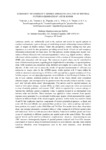Use este identificador para citar ou linkar para este item:
http://www.alice.cnptia.embrapa.br/alice/handle/doc/952223| Título: | Assessment of complexity metrics applied to analysis of spectral patterns generated by aster sensor. |
| Autoria: | VEDOVATO, L. B.  VICENTE, L. E.   PIQUEIRA, J. R. C.   PEREZ FILHO, A.   MATTOS, S. H. V. L.   |
| Afiliação: | LAURA B. VEDOVATO, BOLSISTA CNPM; LUIZ EDUARDO VICENTE, CNPM; JOSÉ ROBERTO CASTILHO PIQUEIRA, USP; ARCHIMEDES PEREZ FILHO, UNICAMP; SÉRGIO HENRIQUE VANNUCCHI LEMES DE MATTOS, UNICAMP. |
| Ano de publicação: | 2012 |
| Referência: | In: SYMPOSIUM SELPER, 15., 2012, Cayenne, French Guiana. Abstracts... Cayenne: SELPER, 2012. |
| Páginas: | 1 p. |
| Conteúdo: | Landscape metrics are traditionally used in the analysis and search for spatial patterns in complex environmental systems through of establishing numeric relationships between different types of targets on Earth's surface. Under this perspective, remote sensing has had great importance as a tool for data generation, providing several levels of land use and occupancy information isonomically for large areas. For that purpose, remote sensing uses regular pixel matrices (Picture Element) with associated quantitative values (e.g. digital numbers, radiance, reflectance) which constitute a direct measurement of the variation of electromagnetic radiation (EMR) after interaction with the target. The variations in pixel values may be considered in terms of their textural patterns, regarding pixel neighborhood relationships, or spectral patterns, when EMR variations are considered along different wavelengths for a same pixel. Thus, the objective of this work was to assess the results of spectral measurements to different area extensions in images taken by the ASTER sensor, which operates with 9 bands within the visible to shortwave infrared region (0.556 to 2.400 µm) and has a spatial resolution of 15 m. For this purpose, cerrado phytophysiognomies in two hillsides at Jataí Ecological Station, in the city of Luiz Antônio, northeast portion of the state of São Paulo, Brazil, were considered reference targets, and encompassed to its greatest extent the cerradão domain and also "campo sujo" and "cerrado strictu sensu" physiognomies. The metrics used for spectral analyses are based on information entropy: measure (SDL), in which most complexity values are associated to more disorderly patterns; and measure, LMC, which is represent by a convex entropy of function that attributes greater complexity values to patterns located in an intermediate zone between order and disorder. These measures was applied to values extracted from spectral response curve generated by a wavelength X reflectance graphic which represented the target's behavior in different bands of the electromagnetic spectrum. In this work, was used two bands (8 and 9) that emphasize important components of cerrado phytophysiognomies, as lignin and water cell. For each hillside, was analysed three positions: base, medium and top, and each of these position, two spatial scales (150x150m and 75x75m). The results shows that, when taken alone, any measure presented a consistent behavior when compared of different spatial scales and bands used. However, both measures show identical behavior to attribute greater and lesser values of complexity to different positions and spatial scale at the same hillside. This results appoint that its can be used in combined as complementary measures, demonstrating in case LMC measure ? heterogeneity degrees of spectral patterns analysed and, from SDL measure, your respective location along of continuum that have in your extremes, one side, more ordered condition (therefore, more homogeneous) and, in the other extremity, more disordered conditions. |
| Palavras-chave: | ASTER Landscape metrics |
| Tipo do material: | Resumo em anais e proceedings |
| Acesso: | openAccess |
| Aparece nas coleções: | Resumo em anais de congresso (CNPM)  |
Arquivos associados a este item:
| Arquivo | Descrição | Tamanho | Formato | |
|---|---|---|---|---|
| DanielGomes.pdf | 156,77 kB | Adobe PDF |  Visualizar/Abrir |









